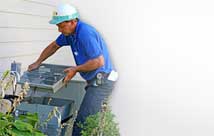Heating and Cooling - Install: Tax credits for homeowners that can be applied next year
| Tweet |
The American Recovery and Reinvestment Act of 2009 (ARRA) rewards homeowners who make energy-saving home improvements, such as installing a programmable thermostat or increasing the level of home insulation in their attics. In fact, due to ARRA incentives, initial federal data shows the average tax refund for 2009 is up nearly 10 percent, or $266, from the previous year, according to Internal Revenue Service Commissioner Doug Shulman.
Homeowners still have time to cash in on these benefits for their 2010 income taxes.
"There's no time better than the present to start saving money on your income taxes, especially when you're doubly rewarded through lower monthly heating and cooling bills," says Mike Lawrence, vice president and general manager of insulation systems for Johns Manville, a manufacturer of building products. "Homeowners have an unprecedented opportunity to improve the energy efficiency of their home using federal tax credits while also positively impacting the comfort and indoor air quality of their home through the products they select."
Here are a few tips for homeowners who want to save money on their income taxes and utility bills.
* Check out federal tax credits.
* Track your qualifying purchases. Applying for federal energy tax credits is simple. For qualifying products purchased this year, homeowners will apply for the tax credit on their 2010 IRS Form (5695). Save receipts from product purchases and the Manufacturer's Certification Statement, a signed statement from the product manufacturer certifying that the product qualifies for the tax credit. These certificates should be available through the manufacturer's Web site and are only to be kept for the homeowner's records.
* Go local for more financial benefits. Additional incentives for making energy efficiency improvements are also available from state and local governments and utilities. The Department of Energy developed a database of state, local, utility and federal incentives and policies that promote renewable energy and energy efficiency. Through the Database of State Incentives for Renewables & Efficiency (DSIRE), homeowners can click on their state and access information on grants, financing options and local rebate programs.
* Start saving today. In addition to tax incentives, homeowners can reduce their home's heating and cooling costs by as much as 20 percent through proper insulation and air sealing techniques, according to the U.S. Environmental Protection Agency (EPA). Homeowners can estimate the current efficiency of their home by using an online energy efficiency assessment tool, such as the Home Energy Analysis test available at JMHomeowner.com. Online assessments are a quick and easy way to gauge the savings that could be realized through energy efficient home improvement projects.
"Because so many American homes are under-insulated, many homeowners will find adding insulation to their attic is a simple, cost-effective project to tackle," said Lawrence. "When adding insulation, homeowners should also consider air sealing their attic to help eliminate any holes or gaps that may exist in the floor or walls. By using caulk, spray foam or weather stripping to close such gaps, homeowners can further decrease wasted energy."
To find more information on energy efficient home improvement projects that qualify for tax credits, visit www.jmhomeowner.com/insulation/energytaxcredit.asp.
Courtesy of ARAcontent.


|
Respond Home Services Directory lists the top Contractors in your area, organized by specialty and office location. |
| Top Cities | |
|
Atlanta
Chicago New York |
Los Angeles
Philadelphia Washington DC |
| Canadian Cities | |
|
Calgary
Edmonton Ottawa |
Toronto
Vancouver Winnipeg |





